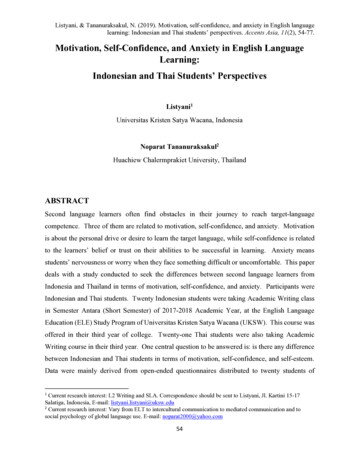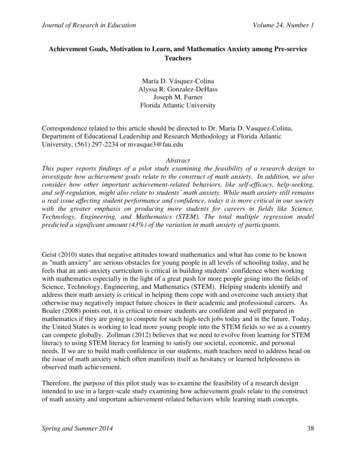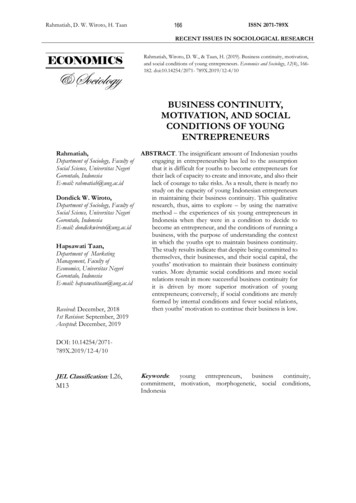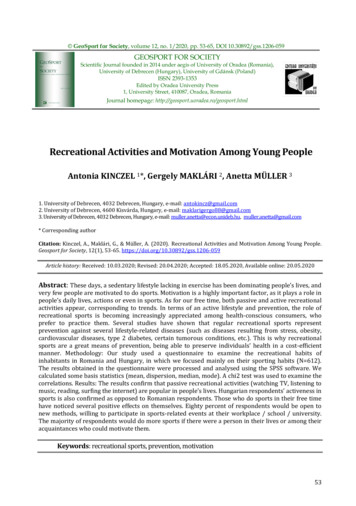
Transcription
Listyani, & Tananuraksakul, N. (2019). Motivation, self-confidence, and anxiety in English languagelearning: Indonesian and Thai students’ perspectives. Accents Asia, 11(2), 54-77.Motivation, Self-Confidence, and Anxiety in English LanguageLearning:Indonesian and Thai Students’ PerspectivesListyani1Universitas Kristen Satya Wacana, IndonesiaNoparat Tananuraksakul2Huachiew Chalermprakiet University, ThailandABSTRACTSecond language learners often find obstacles in their journey to reach target-languagecompetence. Three of them are related to motivation, self-confidence, and anxiety. Motivationis about the personal drive or desire to learn the target language, while self-confidence is relatedto the learners’ belief or trust on their abilities to be successful in learning. Anxiety meansstudents’ nervousness or worry when they face something difficult or uncomfortable. This paperdeals with a study conducted to seek the differences between second language learners fromIndonesia and Thailand in terms of motivation, self-confidence, and anxiety. Participants wereIndonesian and Thai students. Twenty Indonesian students were taking Academic Writing classin Semester Antara (Short Semester) of 2017-2018 Academic Year, at the English LanguageEducation (ELE) Study Program of Universitas Kristen Satya Wacana (UKSW). This course wasoffered in their third year of college. Twenty-one Thai students were also taking AcademicWriting course in their third year. One central question to be answered is: is there any differencebetween Indonesian and Thai students in terms of motivation, self-confidence, and self-esteem.Data were mainly derived from open-ended questionnaires distributed to twenty students of1Current research interest: L2 Writing and SLA. Correspondence should be sent to Listyani, Jl. Kartini 15-17Salatiga, Indonesia, E-mail: listyani.listyani@uksw.edu2Current research interest: Vary from ELT to intercultural communication to mediated communication and tosocial psychology of global language use. E-mail: noparat2000@yahoo.com54
Listyani, & Tananuraksakul, N. (2019). Motivation, self-confidence, and anxiety in English languagelearning: Indonesian and Thai students’ perspectives. Accents Asia, 11(2), 54-77.Academic Writing class in the ELE study program, (Faculty of Language and Arts) FLA, UKSWSalatiga, Indonesia, and 21 students majoring in the English language from HuachiewChalermprakiet University Thailand. Findings showed that students from both countries werevery much influenced by parental factors.INTRODUCTIONEvery language learner has their uniqueness which is different from others’. They havedifferent qualities which make them different. These qualities are, for example, motivation, selfconfidence, self-esteem, self-image, personalities, age, gender, and some others. Three firstmentioned qualities, motivation and self-confidence are closely related to another variable inlanguage learning, which is anxiety.Due to its limitation in time and space, this study deals with three affective factors insecond language acquisition, that is, motivation, self-confidence, and anxiety. Anxiety is verycomplicated in the causes and factors that contribute to it. These three factors are very importantdetermining factors in the journey of second language acquisition.These factors are important in the success of learners’ language learning that we wereinterested in investigating this matter. This study was thus conducted with the aim to find out thedifferences between Indonesian and Thai academic writing students’ motivation, self-confidence,and anxiety. Context of the study were both in Indonesia and Thailand, in the tertiary level, inan academic writing course, to be more specific.REVIEW OF THE LITERATUREMotivationMotivation has proved to be one of the determining factors in learning a foreign or secondlanguage successfully. Gardner and Lambert (1972) initiated a study of motivation in Canadaand applied their efforts over a decade to studying the degree to which motivation can impact theachievement of second language acquisition. Their best-known conceptual framework wasintegrative and instrumental motivation. Language learners who possess integrative motivationtended to identify themselves with the target language group of any native English speakers and55
Listyani, & Tananuraksakul, N. (2019). Motivation, self-confidence, and anxiety in English languagelearning: Indonesian and Thai students’ perspectives. Accents Asia, 11(2), 54-77.had a desire to be more like them or be a part of their society. Such a desire, in turn, lead themto the process of acculturation in a new country, which was crucial for acquiring a secondlanguage (Brown, 1992) because the social and psychological distance between learners and thetarget language group became smaller (Stauble, 1980). On the other hand, a language learneronly had a desire to acquire the target language to advance his or her professional career wasdeemed to be motivated instrumentally.It is evident that many scholars had extensively studied integrative and instrumentalmotivation including Atkinson and Raynor (1974), Fineman (1977), Clement and Kruidenier(1985), Crookes and Schmidt (1991), and Dörnyei (1994, 1998, 2001, 2003). Dörnyei focusedon studying the motivation to acquire a second language.His work titled “MotivationalCharacteristics of Learning Different Target Languages: Results of a Nationwide Survey” (2001:400) which he undertook with Clément, conclusively suggested a synthesis of the constituents ofvarious constructs in motivation into the following seven dimensions: affective/integrative,instrumental/pragmatic, macro-context-related, self-concept-related, goal-related, educationalcontext-related, and significant others-related. The first dimension, which referred to a generalaffective ‘core’ of the second language motivation complex related to attitudes, beliefs and valueswhich were associated with the process, the target and the outcome of learning, included variablessuch as ‘interactiveness’, ‘affective motive’, ‘language attitudes’, ‘intrinsic motivation’, ‘attitudestowards second language learning’, ‘enjoyment’ and ‘interest’. The second referred to extrinsic,largely utilitarian factors such as financial benefit.The third dimension referred to broad,societal, and socio-cultural factors including multicultural, inter-group and ethno-linguisticrelations. The fourth referred to learner-specific variables such as self-confidence, self-esteem,anxiety, and a need for achievement. The fifth is involved with various goal characteristics whilethe sixth referred to the characteristics and appraisal of the immediate learning environment orphysical settings and the school context. The final dimension referred to the influence of parents,family, and friends. Each motivational circumstance was crucial to learning English successfully.In addition to the motivation involved in learning indicated previously, different scholarshave contributed different axioms for successful language learning. For example, Oxford (1990)stressed the importance of self-direction because “self-directed students gradually gain greaterconfidence, involvement, and proficiency” (p.10). Therefore, meta-cognitive strategies andcapability in analyzing language structures may be important for successful language learning56
Listyani, & Tananuraksakul, N. (2019). Motivation, self-confidence, and anxiety in English languagelearning: Indonesian and Thai students’ perspectives. Accents Asia, 11(2), 54-77.(Taguchi, 2002). Krashen (1982) hypothesized the existence of an “Affective Filter” (p. 31),which consisted of high motivation in learning, self-confidence, self-esteem and low anxiety.These are the affective domains that determine learners’ second language acquisition. MacIntyre,Baker, Clement, and Donovan (2003) noted the significant influence of language anxiety and selfperceived competence on second language learning. They authors hypothesized that afterobtaining more language experience, advanced adult learners may willingly communicate withothers, as they become more comfortable with their competence and gain self-confidence inconversing.Learners could acquire a language informally if they voluntarily initiated aconversation which was intended to learn speaking (Skehan, 1989) and did not mind taking risksand making mistakes to achieve language proficiency (Richard-Amato, 1988).Self-ConfidenceSecond language acquisition is one of the aspects of second language learning. Indeed,there are many aspects which spread like a large quilt made of patches. Each of the pieces is anelement of language acquisition which language learners stitch. The more complicated andcolorful the patches, the more beautiful their quilt will be. The patches represent experienced thatlanguage learners have, while the quilt represents the second language learning journey.Second language acquisition has been related to some famous theories such as criticalhypothesis (CPH), language acquisition device (LAD), individual learner hypothesis, and someothers. Bista (2008) claimed that the next component, besides Critical Period Hypothesis (CPH)of Second Language Acquisition (SLA) theories, are all variables which are related to the agefactor. Some of these variables were motivation, anxiety, self-confidence, attitude, and learningstyles. According to Bista (2008), they were responsible for language acquisition in both childrenand adults. Talking about motivation may remind us of Krashen’s theory of affective filterhypothesis. As stated in Diaz-Ducca (2012): Fossilization is seen as a result of the learner’s lack of sufficientmotivation (the other affective variables are self-confidence and anxiety)in spite of the amount of exposure to the L2. In other words, fossilizationis due to the affective filter. Performers with high motivation generallydo better in SLA acquirers vary with respect to the strength or level oftheir Affective Filters. (p. 67)57
Listyani, & Tananuraksakul, N. (2019). Motivation, self-confidence, and anxiety in English languagelearning: Indonesian and Thai students’ perspectives. Accents Asia, 11(2), 54-77.These three things – motivation, self-confidence, and anxiety – seem to be the foundationof language learning success. Just like the name, affective filter hypothesis, these things becomethe filter whether a language learner will be successful in entering the next phase of learning.Hui (2012) also claimed that affective factors determined the proportion of languagelearners’ input and intake. Affective factors included certain emotions or feelings like motivation,self-confidence, anxiety, and some others in the process of acquiring L2. Negative emotions,however, prevented efficient processing of the language input. On the other hand, positiveemotions may have contributed to the efficiency of the acquisition process. If language learnershad high motivation, self-confidence and a low level of anxiety, they may have had low filtersand thus could receive plenty of input. On the other hand, learners with low motivation, littleself-confidence, and a high level of anxiety might have had high filters which could have resultedin little input. Learners’ input were strongly affected by emotional factors, and how much inputwas converted into intake was also affected by these factors.Closely related to affective factors were feelings or emotions.Diaz-Ducca (2012)mentioned that in a classroom setting, the emotions that students felt towards their teacher,program content, and evaluation were also relevant in second language acquisition (SLA). If allthese were positive, they enhanced learning. Munsell, Rauen, and Kinjo (as cited in Diaz-Ducca,2012) further stated that “Language learning should be rich in a variety of stimuli, including butnot limited to information, vision, sound, imagination and intuition, social interaction, movementand reasoning. These positive emotions are aroused by a comfortable classroom environment”(p. 70).Related to classroom setting, Dornyei (as cited in Diaz-Ducca, 2012) mentioned that therewere three components of second language motivation. They were “appraisal of the classroomenvironment” (p. 70), integrative motivation, and linguistic self-confidence.Classroomenvironment involved the cohesion of the group, evaluation of the teacher like competence,rapport, personality, and other things related to the teacher's evaluation, and the last aspect wasthe evaluation of the course itself like relevance, difficulty, and appeal to students. Things whichwere involved in classroom environment could have been translated into “student predisposition”(p. 70). Dornyei, Clement and Noels’ study further confirmed what they call as languageteachers’ intuitive knowledge; what went on in the classroom would considerably affect thelearner’s affective predisposition” (as cited in Diaz-Ducca, 2012, p. 70).58
Listyani, & Tananuraksakul, N. (2019). Motivation, self-confidence, and anxiety in English languagelearning: Indonesian and Thai students’ perspectives. Accents Asia, 11(2), 54-77.AnxietyAnxiety, as a form of negative emotion that seemed to have been more thoroughly studied.A study by Elaine, Horwitz, and Cope (as cited in Diaz-Ducca, 2012) concluded that “teachersand students generally feel strongly that anxiety is a major obstacle to be overcome in learning tospeak another language” (p. 71). Students were reported to have felt “apprehension, worry, evendread”, and also to have “difficulty concentrating, become forgetful, and have palpitations” (p.71). Anxiety developed mainly in SLA performance in the classroom. Included in “performanceanxieties” (p. 71) are communication apprehension, test anxiety, and fear of negative evaluation.In other words, the affective filter rose and motivation decreased which affected self-confidence:“the language learner’s self-esteem is vulnerable to the awareness that the range ofcommunicative choices and
Accents Asia, 11(2), 54-77. 54 Motivation, Self-Confidence, and Anxiety in English Language Learning: Indonesian and Thai Students’ Perspectives Listyani1 Universitas Kristen Satya Wacana, Indonesia Noparat Tananuraksakul2 Huachiew Chalermprakiet University, Thailand ABSTRACT Second language learners often find obstacles in their journey to reach target-language competence. Three of











